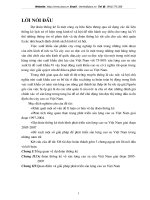Công nghệ về sản phẩm cao su
Bạn đang xem bản rút gọn của tài liệu. Xem và tải ngay bản đầy đủ của tài liệu tại đây (924.88 KB, 12 trang )
Overview of Rubber Processing and
Products
• Many of the production methods used for
plastics are also applicable to rubbers
• However, rubber processing technology is
different in certain respects, and the rubber
industry is largely separate from the plastics
industry
• The rubber industry and goods made of rubber
are dominated by one product: tires
- Tires are used in large numbers on
automobiles, trucks, aircraft, and bicycles
Rubber Processing and Shaping
• Production of rubber goods consists of
two basic steps:
1. Production of the rubber itself
Natural rubber is an agricultural crop
Synthetic rubbers are made from
petroleum
2. Processing into finished goods,
consisting of:
(a) Compounding
(b) Mixing
(c) Shaping
(d) Vulcanizing
The Rubber Industries
• Production of raw NR might be classified
as an
agricultural industry because latex, the
starting
ingredient, is grown on plantations in
tropical climates
• By contrast, synthetic rubbers are
produced by the petrochemical industry
• Finally, processing into tires and other
products occurs at processor (fabricator)
plants, commonly known as the rubber
industry
- The company names include Goodyear, B.
F.
Production of Natural Rubber
• Natural rubber is tapped from rubber trees
(Hevea brasiliensis) as latex
- The trees are grown on plantations in
Southeast
Asia and other parts of the world
• Latex is a colloidal dispersion of solid
particles of the polymer polyisoprene in water
- Polyisoprene (C5H8)n is the chemical
substance that comprises rubber, and its
content in the emulsion
is about 30%
• The latex is collected in large tanks, thus
blending the yield of many trees together
Synthetic Rubber
• Most synthetic rubbers are produced
from petroleum by the same
polymerization techniques used to
synthesize other polymers
• Unlike thermoplastic and thermosetting
polymers, which are normally supplied to
the fabricator as pellets or liquid resins,
synthetic rubbers are supplied to rubber
processors in the form of large bales.
- The rubber industry has a long tradition
of
handling NR in these unit loads
Compounding
• Rubber is always compounded with additives
- Compounding adds chemicals for
vulcanization,
such as sulfur
- Additives include fillers which act either to
enhance the rubber's mechanical properties
(reinforcing fillers) or to extend the rubber to
reduce cost (non‑reinforcing fillers)
- It is through compounding that the specific
rubber
is designed to satisfy a given application in
terms
of properties, cost, and processability
Carbon Black in Rubber
• The single most important reinforcing filler
in rubber is carbon black, a colloidal form of
carbon, obtained by thermal decomposition
of hydrocarbons (soot)
- Its effect is to increase tensile strength
and
resistance to abrasion and tearing of the
final
rubber product
- Carbon black also provides protection from
ultraviolet radiation
- Most rubber parts are black in color
because of
their carbon black content
Other Fillers and Additives in
Rubber
• China clays hydrous ‑ aluminum silicates
(Al2Si2O5(OH)4) provide less reinforcing
than carbon black but are used when
black is not acceptable
• Other polymers, such as styrene, PVC,
and phenolics
• Recycled rubber added in some rubber
products, but usually 10% or less
• Antioxidants; fatigue‑ and
ozone‑protective
chemicals; coloring pigments; plasticizers
and
softening oils; blowing agents in the
production of foamed rubber; and mold
Mixing
• The additives must be thoroughly
mixed with the base rubber to achieve
uniform dispersion of ingredients
• Uncured rubbers have high viscosity
so mechanical working of the rubber can
increase its temperature up to 150°C
(300°F)
• If vulcanizing agents were present
from the start of mixing, premature
vulcanization would result ‑ the “rubber
processor's nightmare”
Two-Stage Mixing
• To avoid premature vulcanization, a
two‑stage mixing process is usually
employed
Stage 1 - carbon black and other
non‑vulcanizing additives are combined
with the raw rubber
The term masterbatch is used for this
first‑stage mixture
Stage 2 - after stage 1 mixing has been
completed, and time for cooling has
been allowed, stage 2 mixing is carried
out in which vulcanizing agents are
added
Filament Reinforcement in Rubber
products
• Many products require filament reinforcement
to reduce extensibility but retain the other
desirable properties of rubber
- Examples: tires, conveyor belts
- Filaments used for this purpose include
cellulose, nylon, and polyester
- Fiber glass and steel ‑ are also used (e.g.,
steel‑belted radial tires)
- Continuous fiber materials must be added
during shaping; they are not mixed like the other
additives.
Shaping and Related
Processes
Shaping processes for rubber products
can be divided into four basic
categories:
1. Extrusion
2. Calendering
3. Coating
4. Molding and casting
• Some products require several basic
processes plus assembly work
- Example: tires
•









